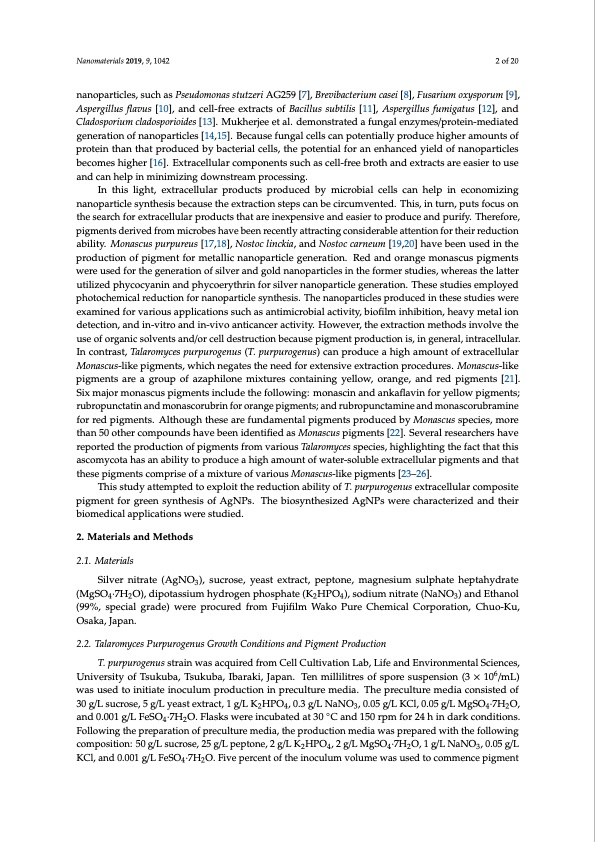
PDF Publication Title:
Text from PDF Page: 002
Nanomaterials 2019, 9, 1042 2 of 20 nanoparticles, such as Pseudomonas stutzeri AG259 [7], Brevibacterium casei [8], Fusarium oxysporum [9], Aspergillus flavus [10], and cell-free extracts of Bacillus subtilis [11], Aspergillus fumigatus [12], and Cladosporium cladosporioides [13]. Mukherjee et al. demonstrated a fungal enzymes/protein-mediated generation of nanoparticles [14,15]. Because fungal cells can potentially produce higher amounts of protein than that produced by bacterial cells, the potential for an enhanced yield of nanoparticles becomes higher [16]. Extracellular components such as cell-free broth and extracts are easier to use and can help in minimizing downstream processing. In this light, extracellular products produced by microbial cells can help in economizing nanoparticle synthesis because the extraction steps can be circumvented. This, in turn, puts focus on the search for extracellular products that are inexpensive and easier to produce and purify. Therefore, pigments derived from microbes have been recently attracting considerable attention for their reduction ability. Monascus purpureus [17,18], Nostoc linckia, and Nostoc carneum [19,20] have been used in the production of pigment for metallic nanoparticle generation. Red and orange monascus pigments were used for the generation of silver and gold nanoparticles in the former studies, whereas the latter utilized phycocyanin and phycoerythrin for silver nanoparticle generation. These studies employed photochemical reduction for nanoparticle synthesis. The nanoparticles produced in these studies were examined for various applications such as antimicrobial activity, biofilm inhibition, heavy metal ion detection, and in-vitro and in-vivo anticancer activity. However, the extraction methods involve the use of organic solvents and/or cell destruction because pigment production is, in general, intracellular. In contrast, Talaromyces purpurogenus (T. purpurogenus) can produce a high amount of extracellular Monascus-like pigments, which negates the need for extensive extraction procedures. Monascus-like pigments are a group of azaphilone mixtures containing yellow, orange, and red pigments [21]. Six major monascus pigments include the following: monascin and ankaflavin for yellow pigments; rubropunctatin and monascorubrin for orange pigments; and rubropunctamine and monascorubramine for red pigments. Although these are fundamental pigments produced by Monascus species, more than 50 other compounds have been identified as Monascus pigments [22]. Several researchers have reported the production of pigments from various Talaromyces species, highlighting the fact that this ascomycota has an ability to produce a high amount of water-soluble extracellular pigments and that these pigments comprise of a mixture of various Monascus-like pigments [23–26]. This study attempted to exploit the reduction ability of T. purpurogenus extracellular composite pigment for green synthesis of AgNPs. The biosynthesized AgNPs were characterized and their biomedical applications were studied. 2. Materials and Methods 2.1. Materials Silver nitrate (AgNO3), sucrose, yeast extract, peptone, magnesium sulphate heptahydrate (MgSO4·7H2O), dipotassium hydrogen phosphate (K2HPO4), sodium nitrate (NaNO3) and Ethanol (99%, special grade) were procured from Fujifilm Wako Pure Chemical Corporation, Chuo-Ku, Osaka, Japan. 2.2. Talaromyces Purpurogenus Growth Conditions and Pigment Production T. purpurogenus strain was acquired from Cell Cultivation Lab, Life and Environmental Sciences, University of Tsukuba, Tsukuba, Ibaraki, Japan. Ten millilitres of spore suspension (3 × 106/mL) was used to initiate inoculum production in preculture media. The preculture media consisted of 30 g/L sucrose, 5 g/L yeast extract, 1 g/L K2HPO4, 0.3 g/L NaNO3, 0.05 g/L KCl, 0.05 g/L MgSO4·7H2O, and 0.001 g/L FeSO4·7H2O. Flasks were incubated at 30 ◦C and 150 rpm for 24 h in dark conditions. Following the preparation of preculture media, the production media was prepared with the following composition: 50 g/L sucrose, 25 g/L peptone, 2 g/L K2HPO4, 2 g/L MgSO4·7H2O, 1 g/L NaNO3, 0.05 g/L KCl, and 0.001 g/L FeSO4·7H2O. Five percent of the inoculum volume was used to commence pigmentPDF Image | Biosynthesis of Silver Nanoparticles Talaromyces purpurogenus

PDF Search Title:
Biosynthesis of Silver Nanoparticles Talaromyces purpurogenusOriginal File Name Searched:
nanomaterials-09-01042.pdfDIY PDF Search: Google It | Yahoo | Bing
Turbine and System Plans CAD CAM: Special for this month, any plans are $10,000 for complete Cad/Cam blueprints. License is for one build. Try before you buy a production license. More Info
Waste Heat Power Technology: Organic Rankine Cycle uses waste heat to make electricity, shaft horsepower and cooling. More Info
All Turbine and System Products: Infinity Turbine ORD systems, turbine generator sets, build plans and more to use your waste heat from 30C to 100C. More Info
CO2 Phase Change Demonstrator: CO2 goes supercritical at 30 C. This is a experimental platform which you can use to demonstrate phase change with low heat. Includes integration area for small CO2 turbine, static generator, and more. This can also be used for a GTL Gas to Liquids experimental platform. More Info
Introducing the Infinity Turbine Products Infinity Turbine develops and builds systems for making power from waste heat. It also is working on innovative strategies for storing, making, and deploying energy. More Info
Need Strategy? Use our Consulting and analyst services Infinity Turbine LLC is pleased to announce its consulting and analyst services. We have worked in the renewable energy industry as a researcher, developing sales and markets, along with may inventions and innovations. More Info
Made in USA with Global Energy Millennial Web Engine These pages were made with the Global Energy Web PDF Engine using Filemaker (Claris) software.
Infinity Turbine Developing Spinning Disc Reactor SDR or Spinning Disc Reactors reduce processing time for liquid production of Silver Nanoparticles.
| CONTACT TEL: 608-238-6001 Email: greg@infinityturbine.com | RSS | AMP |